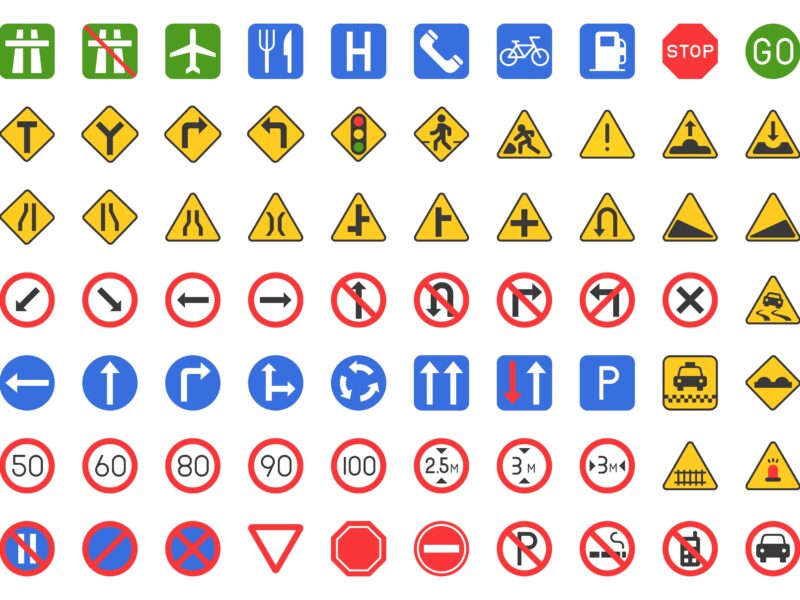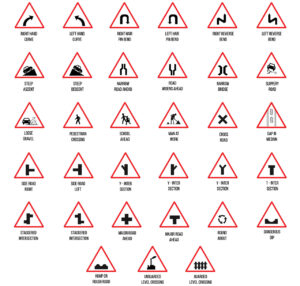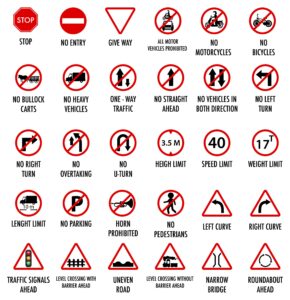
1. Introduction
Road signs are a cornerstone of road safety and traffic management. In India, where traffic conditions vary across urban streets, rural roads, and highways, these signs are crucial for regulating traffic, ensuring safety, and providing essential guidance to road users.
India’s diverse terrains and unpredictable traffic patterns make it important to have well-designed, durable road signs. From sharp turns in hilly areas to school zones in bustling cities, these signs ensure smoother and safer journeys for everyone.
This blog explores the types of road signs, their significance, and why investing in high-quality signage is essential for improving road safety in India.
2. The Role of Road Signs in India’s Road Safety
2.1. Importance of Road Signs in Reducing Accidents
Road signs play a vital role in creating safer road environments for all users. By ensuring compliance with speed limits, pedestrian crossings, and bike lanes, they help regulate traffic and reduce the likelihood of accidents. For instance:
- Speed limit signs encourage drivers to maintain safe speeds.
- Pedestrian crossings ensure safe passage for people on foot.
- Bike lane indicators provide dedicated spaces for cyclists, reducing conflicts with vehicles.
These measures work together to enhance safety and organization on roads, benefiting drivers, pedestrians, and cyclists alike.
2.2. Connection to India’s Traffic Rules Under the Motor Vehicles Act
In India, road signs are governed by the Motor Vehicles Act to ensure uniformity. For example:
- A No Entry sign directs vehicles to avoid restricted zones.
- A Stop sign ensures drivers pause and assess traffic before proceeding.
Following these signs not only enhances safety but also helps users comply with traffic regulations.
2.3. Impact on Creating Discipline and Awareness
Road signs encourage discipline by guiding drivers to follow rules like speed limits and lane usage. They also raise awareness about potential hazards, such as cautionary signs for School Zones or Sharp Turns, helping drivers stay alert and prepared.
3. Classification of Road Signs in India
Road signs in India are classified into three main categories: Mandatory Signs, Cautionary Signs, and Informative Signs. Each type serves a unique purpose, ensuring the safety and convenience of road users.
3.1 Mandatory Signs
Mandatory signs are rules that every road user must follow. They are designed to ensure traffic discipline and safety. These signs tell drivers and pedestrians what they are required to do.
For example, signs like Stop, Speed Limit, No Entry, and One Way are mandatory. Ignoring them can lead to fines, legal penalties, or even accidents.
These signs are usually circular in shape with bold symbols or text to grab attention quickly. For instance, a red-bordered circle with a white background indicates restrictions or prohibitions, while blue circular signs often indicate mandatory actions, like Keep Left.
Mandatory signs are critical because they prevent chaos on the roads by enforcing rules that every driver must obey.
3.2 Cautionary Signs
Cautionary signs warn road users about potential hazards ahead. They are designed to alert drivers so they can prepare for upcoming conditions and avoid accidents.
Examples of cautionary signs include Sharp Turn, School Zone, Animal Crossing, and Slippery Road.
These signs are particularly useful on highways, near schools, or in rural areas where sudden obstacles or dangers may appear. These signs are usually triangular in shape with a red border and a white background, making them easily recognizable. For instance, a sign indicating a Steep Descent Ahead helps drivers slow down and drive cautiously.
Cautionary signs are essential for promoting road safety by helping drivers anticipate and react to possible risks.

3.3 Informative Signs
Informative signs provide road users with helpful information about directions, distances, or nearby facilities. These signs are especially important for smooth navigation, particularly in unfamiliar areas.
Common examples of informative signs include Direction Boards, Distance Markers, Hospital Ahead, and Fuel Station signs. On highways, green boards often display directions to nearby cities, while blue boards mark locations of essential services.
Informative signs are rectangular in shape, with simple text or symbols for quick readability. For example, a sign indicating a Rest Area Ahead ensures drivers can plan their journey efficiently.
By offering clear guidance, informative signs make travel easier and more organized for everyone on the road.

Each of these classifications serves a distinct purpose but works together to ensure safe and smooth travel for all road users. Recognizing and understanding these signs is key to making Indian roads safer and more efficient.
4. Materials and Durability of Road Signs in India
High-quality materials are the backbone of effective road signs. They ensure durability, visibility, and reliability across diverse conditions in India.
4.1. Key Factors Influencing the Effectiveness of Road Signs
The durability and performance of road signs depend on:
- Material Quality: Materials like aluminum and ACP sheets provide strength and weather resistance, making signs long-lasting.
- Design: Bold, simple designs and standardized symbols ensure easy understanding at a glance.
- Visibility: Reflective coatings help signs remain visible in low-light and night conditions, ensuring safety round the clock.
4.2. Common Materials Used for Road Signs
- Aluminum: Lightweight, rust-resistant, and durable, making it suitable for all-weather conditions.
- ACP Sheets: Durable and lightweight, ideal for creating strong and easy-to-install signs.
- Reflective Vinyl: Improves visibility at night by reflecting vehicle headlights for better clarity.
- PVC: Affordable and lightweight, suitable for temporary or less demanding applications.
Using a combination of durable materials like aluminum for strength and reflective vinyl for visibility ensures road signs are both robust and functional. This approach helps signs perform well across various conditions and ensures longevity.
4.3. Importance of Weather-Resistant Signs
India’s diverse climate demands road signs that can withstand extreme heat, heavy rains, and foggy conditions. Weather-resistant coatings and advanced manufacturing techniques prevent fading, corrosion, and damage, ensuring that signs perform effectively in any environment.
5. Challenges in Maintaining Road Signs
Maintaining road signs is essential for road safety but comes with challenges. Both environmental and human factors affect their longevity and effectiveness.
5.1. Environmental Challenges
India’s varied weather conditions can impact road signs significantly:
- Heat: Prolonged exposure to sunlight can cause fading or warping without UV-resistant coatings.
- Rain: Heavy rainfall can corrode signs made from poor-quality materials.
- Pollution: Urban areas face dust and smog buildup, reducing visibility and requiring regular cleaning.
5.2. Human Factors
Human activities also pose challenges to road sign maintenance:
- Vandalism: Graffiti, stickers, or intentional damage can render signs unreadable.
- Theft: Metal signs, particularly aluminum, are often stolen for their scrap value.
- Neglect: In some areas, inadequate maintenance leads to faded or broken signs that fail to serve their purpose.
5.3. The Role of Advanced Manufacturing Techniques
Modern manufacturing techniques help overcome these challenges:
- Weather-Resistant Coatings: Protect against fading, corrosion, and damage from harsh weather.
- Reflective Technology: Improves visibility under low light and foggy conditions.
- Durable Materials: Materials like aluminum composite panels (ACP) and high-quality vinyl ensure resilience against both environmental and human impacts.
- Anti-Theft Features: Tamper-resistant designs deter theft and vandalism, extending the lifespan of road signs.
By addressing these challenges, road signs can remain effective and reliable, contributing to safer and more efficient roads.
6. How to Identify High-Quality Road Signs
High-quality road signs are crucial for ensuring road safety. They must be clear, durable, and compliant with regulations to guide drivers and pedestrians effectively. Here’s how to identify signs that meet the required standards.
6.1. Checklist for Evaluating Road Signs
- Clarity: Ensure the text and symbols are easy to read at a glance.
- Visibility: Reflective materials improve nighttime visibility.
- Material: Durable options like aluminum or ACP sheets resist weathering.
- Compliance: Signs must adhere to IRC and MoRTH standards.
6.2. Simplified Standards and Certifications
Road signs must follow guidelines from the Indian Roads Congress (IRC) and Ministry of Road Transport and Highways (MoRTH). Certifications, like ASTM standards for reflective materials, ensure they meet performance benchmarks.
7. The Future of Road Signs in India
As India’s roads evolve, so do road signs. Modern technology and eco-friendly practices are shaping the next generation of road signs, making them smarter, more sustainable, and better suited to the needs of growing cities.
7.1. Technology-Driven Innovations
- LED Signs: Display real-time updates like weather warnings or traffic conditions.
- Smart Signage: Communicates with vehicles and traffic systems to provide dynamic guidance.
- Solar-Powered Systems: Reduce energy consumption and remain functional in remote areas.
7.2. Role in Smart Cities and Automation
- Connected Infrastructure: Integrates with automated traffic systems for smoother traffic flow.
- Assisting Autonomous Vehicles: Provides machine-readable data for self-driving cars.
7.3. Sustainability Efforts
Sustainability is becoming a key focus in road sign production. Modern designs incorporate eco-friendly practices that benefit both the environment and organizations:
- Recyclable Materials: Road signs made with aluminum or high-grade plastics can be recycled, reducing waste.
- Energy Efficiency: Solar-powered signs and energy-efficient LED lights help minimize energy consumption.
Eco-friendly designs not only reduce environmental impact but also lower long-term costs for governments and organizations by minimizing maintenance and replacement needs. This sustainable approach ensures road signs remain effective while supporting broader environmental goals.
8. Conclusion: Why Investing in Quality Road Signs Matters
Road signs are vital for ensuring road safety and smooth traffic flow. They reduce accidents, guide road users, and provide critical warnings about potential hazards. Investing in high-quality road signs made with durable materials ensures they remain effective and visible in all conditions, making them a key part of a safer and more efficient transportation system.
For those looking to source reliable road signs, partnering with manufacturers who prioritize quality, compliance, and durability is essential. SKYK is a trusted name in the industry, known for crafting durable and reliable mandatory and cautionary signs that meet the highest standards for government and private projects.
With expertly designed signage tailored for diverse conditions, SKYK ensures safer roads and better journeys. Explore more about SKYK’s offerings to find solutions that fit your road safety needs.
Empower safer roads with reliable signage—because every journey deserves the best.

